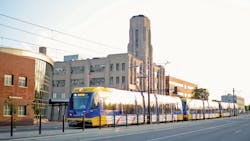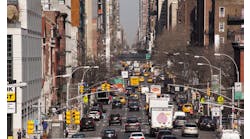By: Dan Soler, P.E., and JoNette Kuhnau, P.E., PTOE
The METRO Green Line (formerly Central Corridor LRT) is the Twin Cities region’s second light rail transit (LRT) line.
The Green Line links five major centers of activity: downtown Minneapolis, the University of Minnesota, the Midway area, the State Capitol complex and downtown St. Paul. In downtown Minneapolis, the Green Line also connects to the METRO Blue Line. Ridership on the Green Line has consistently exceeded projections since it began passenger service in June 2014, with more than 13 million rides through July 2015. The average weekday ridership of 35,320 through July 2015 is already approaching the 2030 projection of 41,000 daily rides.
METRO Green Line train traveling along University Avenue in St. Paul.
The Green Line was constructed through a highly built-up urban environment that presents new challenges for LRT operations in the region. Unlike the Blue Line, which operates through many gated roadway crossings and in an exclusive right-of-way near the Minneapolis-St. Paul International Airport (MSP), nearly the entire Green Line has street-running operations with LRT following the traffic signals, similar to vehicle traffic. For 5.5 miles, about half of its length, the Green Line operates in the center median of University Avenue, a major east-west roadway that connects St. Paul and Minneapolis. This busy commercial corridor has high volumes of pedestrian traffic and is crossed by other major arterials. Green Line trains pass through 68 traffic signals along the length of the alignment, 27 of which are along University Avenue. The large number of closely spaced traffic signals was driven by the need to maintain pedestrian and vehicle access across University Avenue; however, many of the traffic signals have low traffic volumes on the cross streets.
Successful implementation of transit-signal priority (TSP) along the Green Line is essential to achieving reliable, on-time service while crossing a large number of traffic signals. LRT trips that are behind schedule not only impact customer experience and satisfaction, they also result in increased operating costs when additional light-rail trains must be introduced to the operations to maintain planned 10-minute service frequencies. TSP also provides opportunities for schedule recovery after minor disruptions.
Arresting challenges
Metro Transit and the cities of Minneapolis and St. Paul faced several technical challenges in the initial implementation of TSP along the Green Line:
• Only a limited period of real-world testing and refinement was possible before the Green Line began passenger service;
• Only early-green and extended-green TSP strategies were used;
• Traffic-signal timing with TSP was required to serve all phases, maintain coordination, and allow for pedestrian crossings during every signal cycle, which limited available TSP time to approximately 10 seconds;
• Two-way progression along University Avenue was needed for both LRT and vehicle traffic; and
• LRT stations, located approximately every half mile, influenced the progression pattern of LRT compared to vehicle traffic.
In the first several months of operation, TSP along the Green Line did not perform as well as expected, and the predicted benefits of limiting delay at traffic signals were not realized. The line’s scheduled end-to-end run time on opening day was 48 minutes, which required trains to experience no more than 8 minutes of total traffic-signal delay. Data collected on weekday trips showed that, even with TSP and optimized traffic-signal coordination, most trips included 10 to 11 stops at traffic signals along University Avenue. Up to 30% of trains were stopping at traffic signals with low-volume cross streets, and more than 60% of trains were stopping at traffic signals with high volumes on the cross streets. Trains that fell behind the traffic-signal coordination band would consequently stop at many of the downstream traffic signals, which caused them to fall further behind schedule.
A new system
The resulting traffic-signal delays and longer run times led Metro Transit to look for new TSP strategies that would improve Green Line operations and travel times without unduly impacting pedestrians and other vehicle traffic movements. The search for a solution focused on University Avenue in St. Paul, where a large number of closely spaced traffic signals offered the potential for significant travel-time improvements for the Green Line. Metro Transit and the city of St. Paul (the owner and operator of the traffic signals) established three main objectives for the new strategy:
1. Maximize the opportunity for LRT to receive a green signal, based on advanced LRT detection and the predicted arrival of the train at an intersection;
2. Minimize disruption of traffic-signal sequence and vehicle traffic operations, especially skipping of phases; and
3. Avoid causing significant additional delay to pedestrians and vehicle traffic.
An additional objective for the new TSP strategy was to minimize additional infrastructure cost by using the robust in-place LRT detection system, communications infrastructure and traffic-signal controllers that were installed as part of the Green Line project.
The new strategy, known as Predictive Priority, is based on advanced detection of an approaching train approximately 25 to 60 seconds prior to its arrival at the traffic signal. This advanced detection occurs at the adjacent upstream signalized intersection, and is transmitted to the next downstream intersection over the fiber-optic communication network. The system of LRT detection and communications on the Green Line is illustrated in Figure 1.
Figure 1. A model of predictive priority advanced detection infrastructure.
When a traffic-signal controller receives an advanced LRT detection, it begins to transition the signal phases—ending phases early or extending phases, as needed—so that the traffic signal will be green for the LRT phase by the time the train arrives. During the transition, the controller uses specially developed logic to continue serving other pedestrian and vehicle phases that have demand until the train’s expected arrival at the intersection. Once the train enters the intersection, the logic is used to start the LRT clearance sequence and transition as quickly as possible to other pedestrian and vehicle phases that have demand.
The logic, which was developed in close coordination and partnership with the traffic-signal controller vendor, required multiple iterations of testing to produce the final version that would provide the desired traffic-signal operation for LRT, pedestrians and vehicles. Logic and controller testing was completed for numerous scenarios using a virtual traffic-signal controller on a laptop and in a fully built-up traffic-signal controller cabinet at the city of St. Paul. The testing was used to ensure safe operation and to refine the logic to produce the desired signal sequencing under many potential LRT, pedestrian, vehicle traffic and emergency vehicle pre-emption (EVP) demands.
The final logic provided ample opportunities for mainline left-turn and cross-street vehicles to be served before and after the LRT phase, and provided required pedestrian clearance times. In addition, EVP was assigned a higher priority than LRT and was thus allowed to override the LRT Predictive Priority at the intersection.
Prior to implementing Predictive Priority at any of the traffic signals in the corridor, controller logic was installed that used the in-place pedestrian push buttons and vehicle detection to log time-stamped pedestrian and vehicle delays for every signal cycle. The LRT detection system data also was logged to collect data on LRT stops and delays at traffic signals. LRT travel-time data was collected from the light rail Automatic Passenger Counter (APC) system. The LRT, pedestrian and vehicle-delay data were collected for a minimum of three weekdays before Predictive Priority was implemented. Three intersections with relatively low volumes were selected as the pilot implementation for the Predictive Priority operations. The new controller logic was installed at the three intersections in August 2014 and observed closely in the field, followed by an additional three weekdays of delay data collected for LRT, pedestrian and vehicle movements. The data logs were critical to determining whether Predictive Priority was having the intended positive effect on LRT progression without negatively impacting pedestrian and vehicle delay. Compiled data for the three pilot intersections is shown in Table 1.
Figure 2. METRO Green Line LRT travel times before implementation of Predictive Priority , on Aug. 12-14 (n=171 eastbound, 169 westbound trips).
Figure 3. METRO Green Line LRT travel times after implementation of Predictie Priority on Dec. 9-11, 2014 (n=132 eastbound, 128 westbound trips).
Branching out
Following the successful pilot implementation, Predictive Priority was implemented at 17 additional signalized intersections on the University Avenue corridor from August 2014 to December 2014. A process similar to that used for the three pilot intersections was used for the wider implementation of Predictive Priority. Implementations were completed at two to three traffic signals at a time because each signalized intersection had unique characteristics that necessitated adjustments in the timing of the advanced detection and transition periods. Three or more weekdays of delay data was collected before implementation, followed by shop testing, field implementation, and collection of an additional three or more weekdays of data after implementation.
Evaluation of the before-and-after data showed that less than 5% of trains stopped at the traffic signals where Predictive Priority was implemented. This was accomplished while reducing average left-turn and cross-street delays for vehicles, with only a small impact on average pedestrian delays. Most importantly, the implementation of Predictive Priority at the 20 signalized intersections resulted in dramatic reductions in Green Line travel times and improvements in schedule reliability, as shown in Figures 2 and 3.
Average Green Line trip times on University Avenue in St. Paul decreased by 10% to 15%, and on-time performance improved from 60% to 90% of trips. Average travel times in St. Paul over this period were reduced from 34-35 minutes to less than 27 minutes, and variability in run times—a key factor in customer satisfaction—was significantly decreased.
Metro Transit’s experiences with implementing TSP on the METRO Green Line demonstrated that traditional TSP strategies based on early and extended green may not be sufficient to maintain on-time high-frequency transit service in a street-running environment. Predictive Priority is a data-driven TSP approach to provide LRT the best opportunity to progress through traffic signals while minimizing impacts to pedestrian and vehicle traffic. When evaluating potential transit-priority strategies, the first steps need to be identifying operational priorities and understanding the trade-offs between competing priorities when seeking to accommodate a new mode.
Predictive Priority is built on a robust detection and communications system for LRT, pedestrians and vehicle traffic. Therefore, the ability to log and efficiently analyze large volumes of data was critical to developing, fine-tuning and evaluating LRT, pedestrian and vehicle traffic operations. In addition, the selection of an off-the-shelf traffic-signal controller that provides operational flexibility through user-written logic, but is still able to be maintained by the city of St. Paul as part of its larger traffic-signal system, was important to the future management, updating and operation of the system. Finally, frequent and ongoing communication and cooperation between the transit agency and traffic-signal operating agency is critical during planning, testing and implementation to produce a system that meets the needs of both agencies.
The authors wish to acknowledge the invaluable assistance provided by city of St. Paul Traffic Operations, Traffic Control Corp. and Metro Transit Rail Operations in implementing transit-signal priority on the Green Line. TM&E
About The Author: Soler works for Metro Transit. Kuhnau works for Kimley-Horn and Associates, Inc.






